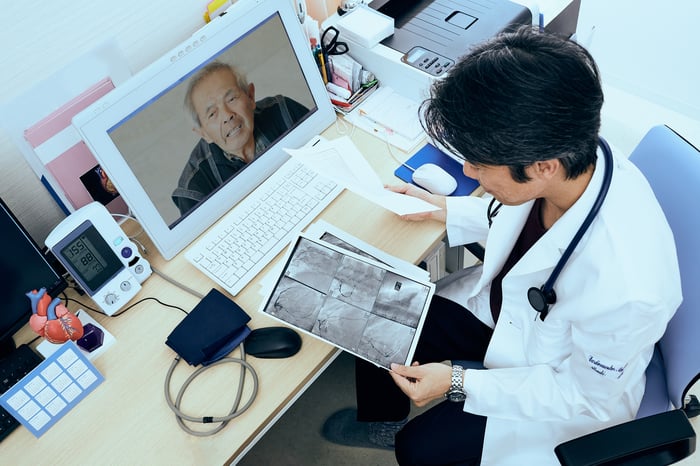Shares of Semler Scientific (SMLR -0.82%) -- a medical device software company providing innovative software for peripheral artery disease (PAD) testing -- fell 25% after the company disappointed investors in its third-quarter earnings. For those unfamiliar, Semler Scientific is redefining how PAD -- a disease that blocks arteries and reduces blood flow to extremities -- is tested by making it easier to get a PAD test. PAD is severely underdiagnosed -- only 2 million people are diagnosed yearly, though Semler estimates that 20 million Americans could have PAD. The reason it is underdiagnosed is that it is difficult and time-consuming to get a PAD test, but Semler is looking to change that.
These results came after the company missed estimates and its growth slowed but is this a red flag for investors? Here's everything you need to know about Semler's third quarter, and whether or not you should be buying the dip today.

Image source: Getty Images.
Why did Semler stock tumble?
Shares of Semler fell primarily because of its misses on top- and bottom-line estimates for Q3. The company missed earnings estimates of $15 million, only reaching $14 million. The company also missed earnings estimates by $0.19 per share, only reaching a net income of $0.51 per share. Semler also saw revenue marginally decrease from the second quarter of 2021. In Q2, it reported $14.3 million in revenue, noting a $300,000 decrease quarter over quarter.
This lack of growth on the revenue side was not the same on the expenses side: While Q3 revenue increased 30% from Q3 2020, its total operating expenses increased nearly 70% to $8.7 million. Its net income, therefore, decreased from $4.9 million in Q3 2020 to $4.2 million in Q3 2021 and its gross margin decreased from 92% to 90%.
The company cited the delta variant, along with a new potential seasonality for its product as the reason for slower growth this quarter. The management team noted that the seasonality might be coming from the way healthcare offices conduct their tests. Management noted that the healthcare offices don't want to be caught in the same position they were caught in 2020, where they were conducting tests moderately until everything shut down. Now, Semler is seeing a ramp-up in testing at the beginning of the year, almost as if offices are trying to get all the tests done as fast as they can.
There are some silver linings
Starting off, analyst estimates are relatively meaningless with a company this size. Semler only has three analysts covering the company. Despite the company's slowdown in revenue growth, it reported strong revenue growth for the nine-month period of 2021 compared to 2020. In the period during 2021, the company has grown revenue by 56% from the same period in 2020 while operating expenses increased by just 44%.
Investors also have to put these results into perspective. The company may have decreasing margins and net income, but Semler's financial position remains incredible. In the face of this earnings miss, the company still maintained gross margins of 90% and net income margins of 30% -- despite Semler being worth under $1 billion in market cap.
Putting the financials aside for the business, nothing materially changed for Semler's investment thesis. The company continues creating a test for PAD that is much faster, easier to use, and cheaper than the Ankle-Brachial Index (ABI) -- the standard form of testing. While the ABI requires a vascular technician, a referral, and cannot be done in primary care offices, Semler's product -- QuantaFlo -- can be done by a primary care physician in just five minutes. More importantly, QuantaFlo can be done without a referral, making it easier for patients to get tested easily to reduce underdiagnoses.
Is now a buying opportunity?
The company still has tremendous potential ahead of itself: PAD affects 20% of people over age 60 and 50% of people over 85, increasing the risk of having a heart attack or stroke by 21%. Semler believes it can test 80 million people every year for PAD, which is magnitudes higher than the 2 million people being currently tested. PAD is underdiagnosed because 75% of patients are asymptomatic, and considering that ABI needs a referral to get tested, it can be incredibly hard for PAD sufferers to get a referral to get tested; QuantaFlo alleviates that problem. The company also has investments in two different private companies working in undisclosed new product areas -- leaving Semler the potential for future optionality.
The lack of sequential growth this quarter shows that Semler's ability to gain broad market adoption will be harder than some investors might have thought. Although this has always been a risk for the company, it has not had to face it previously. Now that Semler faces this risk head-on, some investors are running for the exits. A 25% drop might be excessive, but a drop after the earnings report is somewhat justified.
Despite the risk, this quarter was by no means thesis-breaking, and investors should hold on to their shares. Even though it might not be the time to buy the dip, there does not seem to be a reason to get rid of shares after the reported earnings.





